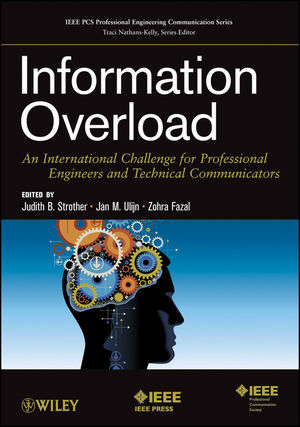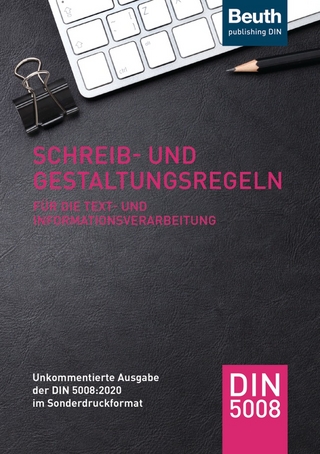
Information Overload
Wiley-IEEE Press (Verlag)
978-1-118-23013-8 (ISBN)
JUDITH B. STROTHER, PhD, is Chair of the Graduate Program in Global Strategic Communication and Professor of Communication at Florida Institute of Technology in Melbourne, Florida. She has written three books and several book chapters, in addition to journal articles and conference proceedings. JAN M. ULIJN, PhD, is an early emeritus of the endowed Jean Monnet Chair in Innovation, Entrepreneurship and Culture at Eindhoven University of Technology, and currently Professor of the Open University School of Management in the Netherlands. He has written numerous journal articles and book chapters and has authored or edited several books. ZOHRA FAZAL is Instructor of Humanities and Communication and a founding member of the Center for Communication Excellence at Florida Institute of Technology. She is currently pursuing her PhD in science education.
List of Practical Insights from Corporations xv
List of Figures xvii
List of Tables xix
Foreword xxi
Preface xxvii
Acknowledgments xxix
A Note from the Series Editor xxxi
Contributors xxxiii
About the Editors xxxvii
1 INFORMATION OVERLOAD: AN INTERNATIONAL CHALLENGE TO PROFESSIONAL ENGINEERS AND TECHNICAL COMMUNICATORS 1
Judith B. Strother, Jan M. Ulijn, and Zohra Fazal
1.1 Definitions, Causes, and Consequences of Information Overload 1
1.1.1 Definitions of Information Overload 1
1.1.2 Causes of Information Overload 2
1.1.3 Consequences of Information Overload 3
1.2 Perspectives on the Concept of Information Overload 4
1.2.1 An Information and Time-Management Perspective 5
1.2.2 A Supplier/Producer/Writer and Client/User/Reader Perspective 5
1.2.3 An International/Intercultural Perspective 7
1.2.4 An Innovation Perspective 7
1.3 Readers of this Book 7
1.4 Structure of this Book 8
1.4.1 Section I: Causes and Costs of Information Overload 8
1.4.2 Section II: Control and Reduction of Information Overload 10
References 11
SECTION I. CAUSES AND COSTS OF INFORMATION OVERLOAD
2 OF TIME MAGAZINE, 24/7 MEDIA, AND DATA DELUGE: THE EVOLUTION OF INFORMATION OVERLOAD THEORIES AND CONCEPTS 15
Debashis “Deb” Aikat and David Remund
2.1 Introduction 16
2.2 Theory and Concept of Information Overload 16
2.3 Information Overload as a Twentieth Century Phenomenon 17
2.4 Evolution of Information and Its Proliferation in Society 21
2.4.1 The Early Quest for Information and Knowledge (320 BCE–Thirteenth Century) 21
2.4.2 The Age of Renaissance (Fourteenth–Seventeenth Century) and the Printing Press 22
2.4.3 The Industrial Revolution (Eighteenth–Nineteenth Century) and Its Information Innovations 23
2.4.4 The Era of the Mind and the Machine (Twentieth Century) 24
2.4.5 Internet Boom and Information Explosion of the 1990s 27
2.4.6 Data Deluge and Information Overload in the Twenty-First Century Digital Age 28
2.5 Information Overload Concepts 29
2.5.1 Definitions of Information Overload and Related Concepts 29
2.5.2 The Context of Information Overload 30
2.5.3 Causes and Consequences of Information Overload 31
2.6 Conclusion and Four Lessons Learned 32
Acknowledgment 33
References 33
PRACTICAL INSIGHTS FROM IBM 39
3 THE CHALLENGE OF INFORMATION BALANCE IN THE AGE OF AFFLUENT COMMUNICATION 41
Paulus Hubert Vossen
3.1 Introduction 42
3.2 Quantitative Aspects of Information Overload 43
3.3 Qualitative Aspects of Information Overload 45
3.3.1 Philosophical Perspective: Information in Science and Technology 45
3.3.2 Political Perspective: Information in Modern Society and a Global World 46
3.3.3 Economic Perspective: Information as a Commodity on the Market 47
3.3.4 Societal Perspective: Information as the Glue Between Communities 48
3.3.5 Psychological Perspective: Information as a Basis for Knowing and Acting 49
3.3.6 Ecological Perspective: Information as a Prerequisite for Living Creatures 50
3.4 Conclusion 51
3.5 A Call for Fundamental Research 52
References 53
PRACTICAL INSIGHTS FROM XEROX 55
Xerox Takes on Information Overload 55
Identifying the Problem 55
Sharing Information 56
Sorting Information 57
Cutting Through the Clutter 57
Life-Saving Software 58
Urban Central Nervous System 58
4 FROM CAVE WALL TO TWITTER: ENGINEERS AND TECHNICAL COMMUNICATORS AS INFORMATION SHAMAN FOR DIGITAL TRIBES 61
Anne Caborn and Cary L. Cooper
4.1 Introduction: The Dawn of the Information Shaman 62
4.2 The Magic of Metaphor 64
4.3 The Audience: The Emergence of Digital Tribes 65
4.4 Quill to Keyboard: The Writer and New Media 66
4.5 Helping the Reader: Techniques for the Information Shaman 68
4.6 The Magic of Hypertext Techniques: Journeys at the Speed of Thought 70
4.7 Conclusion: The Responsibilities of the Information Shaman 72
References 73
PRACTICAL INSIGHTS FROM THE LIMBURG MEDIA GROUP 75
Newspaper Position in The Netherlands 76
Managing Information Overload Using an Evolutionary Approach 76
A Revolutionary Perspective 77
5 THE INFLUENCE OF CULTURE ON INFORMATION OVERLOAD 79
Jan M. Ulijn and Judith B. Strother
5.1 Introduction 80
5.2 Levels of Culture 81
5.3 Cultural Patterns of Discourse Organization 82
5.4 High Context Versus Low Context 83
5.5 Internationalization Versus Localization 85
5.5.1 Latin America 86
5.5.2 Japan 87
5.5.3 China 87
5.6 The Effect of Professional Culture 88
5.7 Japan and U.S. Discourse Structures 91
5.8 Cultural Issues in Reader Versus Writer Responsibility 92
5.9 Implications for Engineers and Technical Communicators and Their Corporations 93
5.10 Conclusion 95
References 95
PRACTICAL INSIGHTS FROM A2Z GLOBAL LANGUAGES 99
6 EFFECT OF COLOR, VISUAL FORM, AND TEXTUAL INFORMATION ON INFORMATION OVERLOAD 103
No€el T. Alton and Alan Manning
6.1 Introduction 104
6.2 Previous Studies of Decorative and Indicative Effects 106
6.3 Experiments and Results 111
6.3.1 Study One: Restaurant Menu Design 112
6.3.2 Study Two: Graph Design and Recall Accuracy 114
6.3.3 Study Three: Diagram Design and Recall Accuracy 116
6.4 Practical Implications for Engineers and Technical Communicators 117
6.5 Conclusion 119
References 121
PRACTICAL INSIGHTS FROM APPLIED GLOBAL TECHNOLOGIES 123
7 COST OF INFORMATION OVERLOAD IN END-USER DOCUMENTATION 125
Prasanna Bidkar
7.1 Introduction 126
7.2 Information Overload 126
7.3 Causes of Information Overload 128
7.4 Sources of Noise in User Documentation 129
7.4.1 Information Content 129
7.4.2 Channel 130
7.4.3 Receiver 131
7.5 Effects of Information Overload on Users 132
7.6 The Current Study 133
7.6.1 The Survey 133
7.6.2 Results and Observations 133
7.7 Cost of Information Overload 135
7.7.1 Cost Framework 135
7.7.2 Scenario 1: Ideal Scenario 136
7.7.3 Scenario 2 136
7.7.4 Scenario 3 136
7.7.5 Scenario 4 136
7.7.6 An Example from the User’s Perspective: Denim Corp 137
7.7.7 An Example from the Producer’s Perspective: Logistics Corp 137
7.8 Conclusion 138
References 139
PRACTICAL INSIGHTS FROM HARRIS CORPORATION 141
Sources of Information Overload 141
Strategies for Dealing with Information Overload 142
SECTION II. CONTROL AND REDUCTION OF INFORMATION OVERLOAD: EMPIRICAL EVIDENCE
8 TAMING THE TERABYTES: A HUMAN-CENTERED APPROACH TO SURVIVING THE INFORMATION DELUGE 147
Eduard Hoenkamp
8.1 Introduction 148
8.2 Reducing Information Overload by Being Precise About What We Ask for 150
8.2.1 Conversational Query Elaboration to Discover Support Groups 150
8.2.2 Constructing Verbose Queries Automatically During a Presentation 151
8.3 Steering Clear of Information Glut Through Live Visual Feedback 152
8.4 Improving Search Engines by Making Them Human Centered 156
8.4.1 Case 1: The Basic Level Category 158
8.4.2 Case 2: The Complex Nominal 162
8.4.3 Case 3: Exploiting Natural Language Properties 165
8.5 Conclusion 167
Acknowledgments 167
References 168
PRACTICAL INSIGHTS FROM THE LABORATORY FOR QUALITY SOFTWARE 171
References 173
9 TECHNOLOGIES FOR DEALING WITH INFORMATION OVERLOAD: AN ENGINEER’S POINT OF VIEW 175
Toon Calders, George H. L. Fletcher, Faisal Kamiran, and Mykola Pechenizkiy
9.1 Introduction 176
9.2 Information Overload: Challenges and Opportunities 177
9.3 Storing and Querying Semistructured Data 179
9.3.1 XML as a Data Format for Semistructured Data 180
9.3.2 RDF as a Data Format for Semistructured Data 181
9.3.3 Remarks on the Use of XML and RDF 183
9.4 Techniques for Retrieving Information 183
9.5 Mining Large Databases for Extracting Information 187
9.6 Processing Data Streams 190
9.7 Summary 190
References 191
PRACTICAL INSIGHTS FROM THE COLLEGE OF AERONAUTICS, FLORIDA INSTITUTE OF TECHNOLOGY 195
From Data to Information to Situational Awareness to Decisions 196
Transformative Airspace Architecture 197
Robust, Agile, and Intelligently Responsive Information-Sharing Architecture 197
Next Generation Efforts to Manage Information 198
Distributed Decision Making 199
System-Wide Information Management (SWIM) 200
Shared Situation Awareness and Collaborative Decision Making 201
Automation and Information in the NAS 201
Summary 201
References 202
10 VISUALIZING INSTEAD OF OVERLOADING: EXPLORING THE PROMISE AND PROBLEMS OF VISUAL COMMUNICATION TO REDUCE INFORMATION OVERLOAD 203
Jeanne Mengis and Martin J. Eppler
10.1 The Qualitative Side of Information Overload 204
10.2 Causes of Information Overload 206
10.3 How Information Visualization Can Improve the Quality of Information and Reduce Information Overload 208
10.4 Using Visualization in Practice: Understanding the Knowing–Doing Gap 209
10.5 Methods and Context of the Study 211
10.5.1 Measures 211
10.5.2 Procedure and Analysis 213
10.6 Indications of the Knowing–Doing Gap: Visuals Are Valued, but Poorly Used 214
10.7 Understanding the Knowing–Doing Gap with TAM 214
10.8 Discussion 216
10.9 Conclusion 217
10.10 Future Research Directions 218
10A.1 Appendix 219
References 222
PRACTICAL INSIGHTS FROM ALVOGEN 227
The Challenges of Information Overload 227
Strategies for Dealing with Information Overload 228
11 DROWNING IN DATA: A REVIEWOF INFORMATION OVERLOAD WITHIN ORGANIZATIONS AND THE VIABILITY OF STRATEGIC COMMUNICATION PRINCIPLES 231
David Remund and Debashis “Deb” Aikat
11.1 Introduction 232
11.2 Defining Information Overload within Organizations 232
11.3 Evolution of the Information Overload Concept in Organizations 234
11.4 Implications of Information Overload within Organizations 235
11.4.1 Organizational Implications 235
11.4.2 Employee Implications 237
11.5 Traditional Strategies for Addressing Information Overload 238
11.5.1 Organizational Strategies 238
11.5.2 Individual Strategies 239
11.6 Strategic Communication Principles: A Viable Solution? 240
11.7 Putting Strategic Communication into Practice 242
11.8 Further Research 243
11.9 Conclusion 243
References 243
PRACTICAL INSIGHTS FROM THE DUTCH EMPLOYERS’ ASSOCIATION 247
Acting as an Information Resource 248
Focusing on the Added Value of Information 248
Co-Creating Added Value in Interaction with Companies 249
A Final Observation 250
References 250
12 BLINDFOLDED THROUGH THE INFORMATION HURRICANE? A REVIEW OF A MANAGER’S STRATEGY TO COPE WITH THE INFORMATION PARADOX 251
Arjen Verhoeff
12.1 Introduction 252
12.2 Decomposing the Information Paradox 253
12.2.1 The Control of the Internal Information Process 253
12.2.2 The Control of the External Information Process 254
12.3 A Framework to Analyze the Information Paradox 255
12.3.1 Do Managers Experience Issues Regarding Information? 257
12.3.2 Do Managers Use an Information Strategy? 257
12.3.3 Do Managers Use a Strategy to Transform Information into Added Value? 257
12.4 Illustrating the Framework with Some Dutch Empirical Evidence 258
12.4.1 The Importance of an Information Strategy 258
12.4.2 Preliminary Survey Among Dutch Managers 259
12.5 Discussion and Conclusion: Lessons in Information Strategy 260
12.5.1 Discussion 260
12.5.2 Methodological Grounding 261
12.5.3 Learning Points 261
12.5.4 Applied Innovative Directions 262
12.5.5 Toward an Innovative Research Agenda 264
12.5.6 General Conclusion 264
References 265
List of References for Boxed Quotations 267
Author Index 269
Subject Index 275
| Reihe/Serie | IEEE PCS Professional Engineering Communication Series |
|---|---|
| Sprache | englisch |
| Maße | 178 x 254 mm |
| Gewicht | 562 g |
| Themenwelt | Geisteswissenschaften ► Sprach- / Literaturwissenschaft ► Literaturwissenschaft |
| Mathematik / Informatik ► Informatik ► Netzwerke | |
| Technik ► Nachrichtentechnik | |
| ISBN-10 | 1-118-23013-2 / 1118230132 |
| ISBN-13 | 978-1-118-23013-8 / 9781118230138 |
| Zustand | Neuware |
| Haben Sie eine Frage zum Produkt? |
aus dem Bereich


